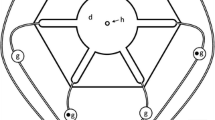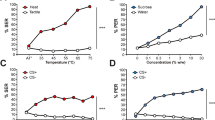Abstract
Differential training of honeybee workers using the proboscis extension reflex is applied to the problem of evaluating compounds that may potentially provide cues for kin recognition in the honeybeeApis mellifera. These cues were obtained by contaminating glass rods and steel needles with different materials found in the hive. In particular it is shown that workers discriminate between: cuticular waxes from different adult workers; eggs from the same and different hives; similar aged larvae within the same hive; and needles contaminated with the Nasonov gland secretions of different adult workers. It appears that some of these differences are due to phenotypic variation among individuals that cannot be directly attributed to environmental factors.
Similar content being viewed by others
References
Bitterman, M.E., Menzel, R., Fietz, A. andSchäfer, S. 1983. Classical conditioning of proboscis extension in honeybees (Apis mellifera).J. Comp. Psychol. 97:107–119.
Breed, M. 1981. Individual recognition and learning of queen odours by worker honey bees.Proc. Natl. Acad. Sci. U.S.A. 78:2635–2637.
Breed, M., andBennett, B. 1987. Kin recognition in highly eusocial insects, pp. 243–286,in D. Fletcher and C. D. Michener (eds.). Kin Recognition in Animals. Wiley, New York.
Breed, M., Butler, L., andStiller, T.M. 1985. Kin discrimination by worker honeybees in genetically mixed groups.Proc. Natl. Acad. Sci. U.S.A. 82:3058–3061.
Buckle, G.R., andGreenberg, L. 1981. Nestmate recognition in sweatbees (Lasioglossum zephyrum): Does an individual recognize its own odour or only odours of its nestmates?Anim. Behav. 29:802–809.
Carlin, N.F., andHölldobler, B. 1986. The kin recognition system of carpenter ants (Camponotus spp.). I. Hierarchical cues in small colonies.Behav. Ecol. Sociobiol. 19:123–134.
Carlin, N.F., andHölldobler, B. 1987. The kin recognition system of carpenter ants (Camponotus spp.). II. Larger colonies.Behav. Ecol. Sociobiol. 20:209–217.
Carlin, N.F., Hölldobler, B., andGladstein, D.S. 1987. The kin recognition system of carpenter ants (Camponotus spp.). III. Within colony discrimination.Behav. Ecol. Sociobiol. 20:219–227.
Carlson, D., andBolten, A.B. 1984. Identification of Africanized and European honeybees, using extracted hydrocarbons.Bull. Entomol. Soc. Am. 30(2):32–35.
Clement, J.L., Bonavita-Cougourdan, A., andLange, C. 1987. Nestmate recognition: The role of cuticular hydrocarbons in the antCamponotus vagus Scop,in J. Eder and H. Rembolt (eds.).Proc. 10th Int. Congress IUSSI, Verlag Peperny, Munich. In press.
Crewe, R.M. 1982. Composition variability, the key to the social signals produced by honey bee mandibular glands, pp. 318–322,in M.D. Breed, C.D. Michener, and H.E. Evans (eds.). Biology of the Social Insects. tview Press, Boulder, Colorado.
Free, J.B., andWinder, M.E. 1983. Brood recognition by honeybee (Apis mellifera) workers.Anim. Behav. 31:539–545.
Frumhoff, P.C., andSchneider, S. 1987. The social consequence of honeybee polyandry: Kinship influences worker interactions within colonies.Anim. Behav. 35:255–262.
Gadagkar, R. 1985. Kin recognition in social insects and other animals—a review of recent findings and a consideration of their relevance for the theory of kin selection.Proc. Indian Acad. Sci. (Anim. Sci.) 94:587–621.
Gamboa, G.J., Reeve, H.K., andPfennig, D.W. 1986a. The evolution and ontogeny of nestmate recognition in social wasps.Annu. Rev. Entomol. 31:431–454.
Gamboa, G.J., Reeve, H.K., Ferguson, I., andWacker, T.L. 1986b. Nestmate recognition in social wasps: The origin and acquisition of recognition odours.Anim. Behav. 34:685–695.
Getz, W.M., Brückner, D., andSmith, K.B. 1986. Conditioning honeybees to discriminate between heritable odors from full and half sisters.J. Comp. Physiol. A 159:251–256.
Getz, W.M., andChapman, R.F. 1987. An odor discrimination model with application to kin recognition in social insects.Int. J. Neurosci. 32:963–978.
Getz, W.M., andSmith, K.B. 1983. Genetic kin recognition: Honeybees discriminate between full and half sisters.Nature 302:147–148.
Getz, W.M., andSmith, K.B. 1986. Honeybee kin recognition: Learning self and nestmate phenotypes.Anim. Behav. 34:1617–1626.
Getz, W.M., andSmith, K.B. 1987. Olfactory sensitivity and discrimination of mixtures in the honeybeeApis mellifera.J. Comp. Physiol. A. 160:239–245.Jaycox, E.R. 1970. Honeybee foraging behavior: Responses to queens, larvae, and extracts of larvae.Ann. Entomol. Soc. Am. 63:1689–1694.
Morel, L., andVander Meer, R.K. 1987. Nestmate recognition inCamponotus floridanus: behavioral and chemical evidence for the role of age and social experience,in J. Eder and H. Rembolt (eds.). Proceedings of the 10th International Congress of the IUSSI. Verlag Peperny, Munich. In press.
Noonan, K.C. 1985. Kin recognition in the honeybee (Apis mellifera): In-colony studies of workers/brood recognition. PhD dissertation. University of Wisconsin, Madison.
Obin, M.S. 1986. Nestmate recognition cues in the laboratory and field colonies ofSolenopsis invicta Buren (Hymenoptera: Formicidae): Effect of environment and role of cuticular hydrocarbons.J. Chem. Ecol 12:1965–1975.
Page, R.E., andErickson, E.H. 1984. Selective rearing of queens by worker honeybees: kin or nestmate recognition.Ann. Entomol. Soc. Am. 77:578–580.
Pickett, J.A., Williams, I.H., Martin, A.P., andSmith, M.C. 1980. The Nasonov pheromone of the honeybee,Apis mellifera L. (Hymenoptera, Apidae). Part I. Chemical characterization.J. Chem. Ecol. 6:425–434.
Renner, M., 1960. Das Duftorgan der Honigbiene und die physiologische Bedeutung ihres Lockstolfes.Z. Vergl. Physiol. 43:411–468.
Smith, B.H., andWenzel, J.W. 1988. Pheromonal covariation and kinship in the social beeLasioglossum zephyrum (Hymenoptera, Halictidae).J. Chem. Ecol. 14:87–94.
Visscher, P.K. 1986. Queen rearing by honey bees (Apis mellifera).Behav. Ecol. Sociobiol. 18:453–460.
Author information
Authors and Affiliations
Rights and permissions
About this article
Cite this article
Getz, W.M., Brückner, D. & Smith, K.B. Variability of chemosensory stimuli within honeybee (Apis mellifera) colonies: Differential conditioning assay for discrimination cues. J Chem Ecol 14, 253–264 (1988). https://doi.org/10.1007/BF01022545
Received:
Accepted:
Issue Date:
DOI: https://doi.org/10.1007/BF01022545




